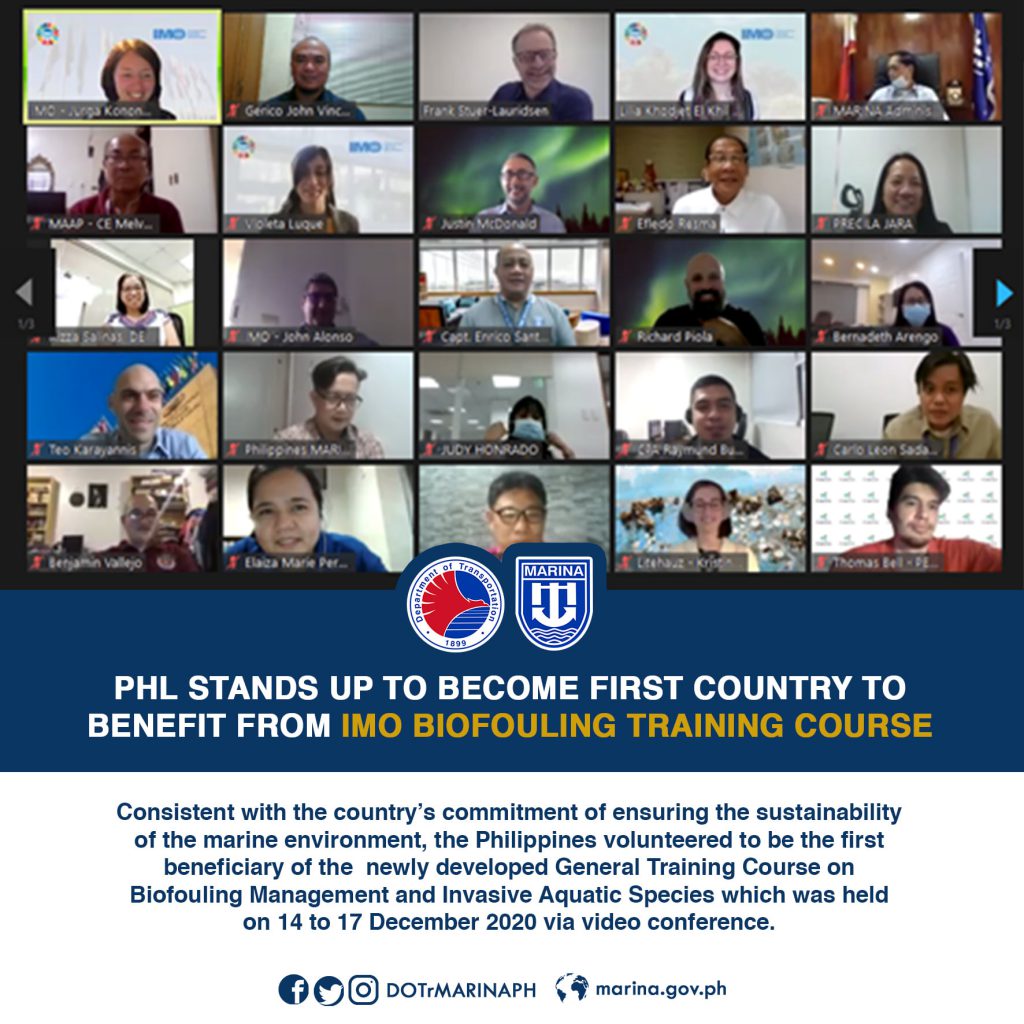Consistent with the country’s commitment of ensuring the sustainability of the marine environment, the Philippines volunteered to be the first beneficiary of the newly developed General Training Course on Biofouling Management and Invasive Aquatic Species which was held on 14 to 17 December 2020 via video conference.

The Maritime Industry Authority (MARINA), in coordination with the International Maritime Organization (IMO), convened the said training course which aims to have a general understanding of the issues, potential impacts, different tools available for biofouling management, and the contents of the IMO Biofouling Guidelines. The said training course will likewise provide the country with detailed information to the multiple aspects related to marine biofouling, its role as a pathway for the introduction of invasive aquatic species, and the management solutions and technologies that are available.
Commencing the event, the MARINA Administrator, VAdm Robert A Empedrad AFP (Ret), reiterated our commitment of minimizing, if not eliminate, the harmful impacts of aquatic biofouling to the marine environment as one of the Lead Partnering Countries of the GloFouling Project.
“[Let us] be stewards of this social and shared responsibility of ensuring the sustainability and protection of our marine environment,” VAdm Empedrad said.
During the said training course, Dr. Frank Stuer-Lauridsen discussed about biofouling, invasive species, and the reactive practices to combat biofouling. He likewise talked about the IMO Biofouling Guidelines, which is intended to provide a globally consistent approach to the management of biofouling. He also explained about the legislations and requirements for biofouling of other countries.
Dr. Justin McDonald and Dr. Dinis Oliveira provided presentations on the factors influencing biofouling and its environmental co-benefits, respectively.
On the other hand, Dr. Richard Piola shared his expertise regarding the preventive practices on biofouling.
The discussions continued with presentations of case studies. The participants were introduced to the new training methodology of interactive activities such as but not limited to – live presentations with recorded video snippets; live questions and answers (Q & A) sessions; quizzes and polls and role-playing, which encouraged adaptive thinking based on the knowledge acquired during the said training course.
The MARINA Deputy Administrator for Operations, Engr. Nannette Z. Villamor – Dinopol, concluded the activity by expressing her gratitude to the IMO for their unwavering support to the Philippine maritime industry and to the speakers for sharing their expertise and knowledge as well as to the participants for their time and active participation during the said training course.
The Training Course was attended by the IMO Regional Presence Coordinator, Atty. Josephine Marie G. Uranza, representatives from the Department of Transportation (DOTr), Department of Foreign Affairs (DFA), MARINA, Philippine Coast Guard (PCG), Philippine Ports Authority (PPA), Subic Bay Metropolitan Authority (SBMA), Cebu Port Authority (CPA), Biodiversity Management Bureau – Department of Environment and Natural Resources (BMB-DENR), Bureau of Fisheries and Aquatic Resources (BFAR), Department of Science and Technology – Philippine Council for Industry, Energy and Emerging Technology Research and Development (DOST-PCIEERD), University of the Philippines – Marine Science Institute (UP – MSI), University of the Philippines – Institute of Environmental Science and Meteorology, (UP – IESM), AMOSUP Seamens’ Training Center, Authority of the Freeport Area of Bataan (AFAB), Philippine Association of Maritime Institutions (PAMI), and PORTEC.
Biofouling and Invasive Aquatic Species
The IMO Biofouling Guidelines of 2011 defined biofouling as the accumulation of aquatic organisms such as microorganisms, plants, and animals on surfaces and structures immersed in or exposed to the aquatic environment.
Biofouling is mostly found in the submerged areas of vessels of all sorts and the aquatic environment, permanent structures in ports, bouts, platforms, and energy facilities. It can also be obtained in aquaculture cages, nets, and other structures.
On the other hand, invasive aquatic species (IAS) are species, which may pose threats to human, animal and plant life, economic and cultural activities, and the aquatic environment.
The spread of IAS is now considered a major threat to the world’s oceans, ecological, and economic well-being as the said species are causing vast damages to biodiversity.


